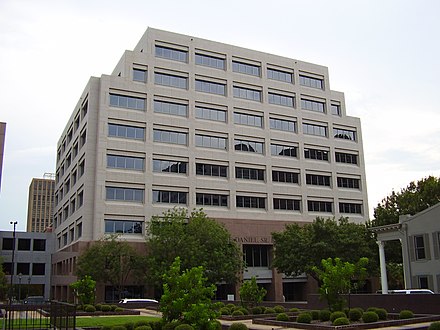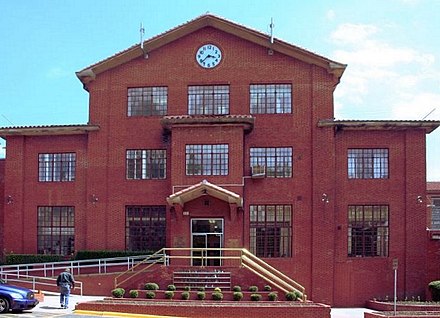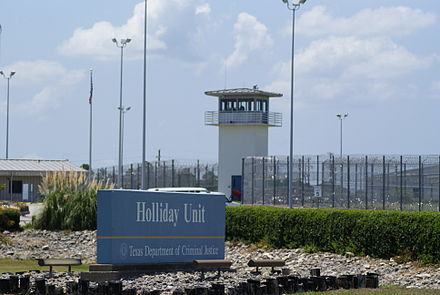The Texas Department of Criminal Justice (TDCJ) is a department of the government of the U.S. state of Texas. The TDCJ is responsible for statewide criminal justice for adult offenders, including managing offenders in state prisons, state jails, and private correctional facilities, funding and certain oversight of community supervision, and supervision of offenders released from prison on parole or mandatory supervision. The TDCJ operates the largest prison system in the United States.[2]
The department has its headquarters in the Brad Livingston Administrative Headquarters in Huntsville and offices at the Price Daniel Sr. Building in downtown Austin.[3][4]
In 1848, the Texas Legislature passed "An Act to Establish a State Penitentiary", which created an oversight board to manage the treatment of convicts and administration of the penitentiaries. Land was acquired in Huntsville and Rusk for later facilities.[5]
The prison system began as a single institution, located in Huntsville. A second prison facility, Rusk Penitentiary, began receiving convicts in January 1883.[5] Before the Ruiz v. Estelle court case, the Texas Department of Corrections had 18 units, including 16 for males and two for females.[6]
Various administrative changes where the organization of the managing board of the department occurred over the next 100 years.[5]
In 1921, George W. Dixon of The Prison Journal published a report on the Texas Prison System facilities. His article stated that the prisons were among the most "brutal" in the world. Dixon said that the prisons featured corporal punishment such as whipping, beatings, and isolation.[7]
In July and August 1974, a major riot at the Huntsville Walls prison resulted in the murder of two hostages. This was not a riot, but an escape attempt in which the whole Huntsville Unit was shut down. Inmates were Fred Gomez Carrasco, Rudolpho Domingez and Ignacio Cueves.
In 1979, Ruiz v. Estelle found that the conditions of imprisonment within the TDC prison system constituted cruel and unusual punishment in violation of the United States Constitution.[8][9] The decision led to federal oversight of the system, with a prison construction boom and "sweeping reforms ... that fundamentally changed how Texas prisons operated."[10][11]
In 1989, the TDCJ and the Board of Criminal Justice were created. The board is composed of nine members appointed by the governor with the advice and consent of the senate to six-year, overlapping terms. This new agency absorbed functions of three state agencies - the Texas Department of Corrections, the Texas Board of Pardons and Paroles, and the Texas Adult Probation Commission.[12]
In the 1980s, the government of Texas began building more prisons. During that decade, impoverished rural communities viewed the prisons as a boon, as they provided jobs.[13]
In 1987, the Texas State Board of Corrections voted to build two new 2,250-inmate maximum-security prisons in Gatesville and Amarillo and several 1,000-inmate medium-security prisons in Liberty County, Marlin, Snyder, and Woodville. The TDC units in Amarillo and Snyder were the first ones located outside of Central Texas and East Texas.[14]
James Anthum "Andy" Collins, the executive director of the TDCJ from April 10, 1994, to around December 1995, became a consultant for VitaPro, a company selling a meat substitute that was used in Texas prisons.[15] Shirley Southerland, a prisoner at the Hobby Unit, stated that her fellow prisoners discovered that the VitaPro product was intended for consumption by canines. Collins arranged for VitaPro to be used while he was still the head of the TDCJ.[16] Collins had awarded a $33.7 million contract to the company. Robert Draper of the Texas Monthly accused various TDCJ board members and state officials in the early to mid-1990s of capitalizing on the rapid expansion of Texas prisons – from 1994 to 1996 the number of prisoners almost doubled and the number of the prison units increased from 65 to 108 – and trying to establish favorable business contracts and get prisons named after them. Draper reasoned, "If [Allan B. Polunsky] and other board members didn't care about ethics, why should Andy Collins?"[15]
According to a December 2007 survey of prisoners from the U.S. Bureau of Justice Statistics, five TDCJ units, Allred Unit, Clemens Unit, Coffield Unit, Estelle Unit, and Mountain View Unit, were among those in the United States with the highest numbers of reported prison rape cases in 2006. In 2007, the TDCJ reported a total of 234 reported sexual assaults in its prisons. Michelle Lyons, the TDCJ spokesperson, said, "The actual reports we have are not consistent with the results in the survey, but because it's anonymous, there's no way for us to verify that additional number."[17]
In 2008, the TDCJ planned to install cell phone-jamming devices at its units, but encountered resistance from cell phone companies.[18]
In 2014, the Human Rights Clinic of the University of Texas School of Law released a report stating that the temperatures in many TDCJ units are too high over the summer and that at least 14 inmates had been killed by the heat since 2007. In 2013, the TDCJ had signed a deal for a climate-controlled housing system for pig breeding; this was worth $750,000.[19] In response, John Whitmire of the Texas State Senate stated, "the people of Texas don't want air-conditioned prisons, and there's a lot of other things on my list above the heat. It's hot in Texas, and a lot of Texans who are not in prison don't have air conditioning."[20] That year, a federal judge declared that the TDCJ is making it impossible for Muslim inmates to practice their religion.[21]
In 2017, the use of solitary confinement as punishment was ended.[22]


The Texas Board of Criminal Justice oversees the TDCJ. The board selects the executive director, who manages the TDCJ.[23] The members of the board are appointed by the Governor of Texas.[24]
The department encompasses these major divisions:

The Correctional Institutions Division, which operates secure correctional facilities for adults, has its headquarters in the Brad Livingston Administrative Headquarters in Huntsville.[25] TDCJ-CID, formed in 2003, was a merger of the Institutions Division, the Operations Division, the Private Facilities Division, and the State Jail Division.[26]
The division operates prisons, which are facilities for people convicted of capital offenses and people convicted of first-, second-, and third-degree felony offenses, and state jails, facilities for people convicted of state jail felony offenses. Before the 2003 formation of the Correctional Institutions Division, the Institutional Division operated prisons and the State Jail Division (TDCJ-SJD[27]) operated state jails.[28] As of 2010, of the counties in Texas, the five with the highest numbers of state prisons and jails were Walker, Brazoria and Coryell (tie), and Anderson and Liberty (tie).[29][30]
As of 2001, prisons may be named after people who are dead or who are still alive, and namesakes have included Governors of Texas, TDCJ employees, members of the Texas House of Representatives, mayors, police officers, and judges. In previous eras, prisons were only named after deceased TDCJ employees and state governors. By the 2000s, so many new prisons were being built that the TDCJ had to change its naming policy.[31]
Regional offices of the CID are: Region I, headquartered in Huntsville; Region II, headquartered on TDCJ prison property in Anderson County, near Palestine; Region III, headquartered on the property of the Darrington Unit in Brazoria County, near Rosharon; Region IV, headquartered in the former Chase Field Industrial Complex (a TDCJ property) in Beeville; Region V, headquartered in Plainview; and Region VI, headquartered on TDCJ property in Gatesville.[32]

Most of the TDCJ prisons are located in the historic cotton slavery belt around the former location of Stephen F. Austin's colony. Counties that have housed adult correctional facilities, such as Brazoria, Fort Bend, Polk, and Walker, once had slave majority populations. Many of the largest prison farms and prison properties in the state, including Goree Unit, the Jester units, Polunsky Unit, the Ramsey units, and Wynne Unit, are located in those counties. The state of Texas began building adult prisons outside of the historic cotton belt in the 1980s.[33]
Some units have employee housing; most employee housing was constructed prior to the TDCJ's early to mid-1990s prison expansion. As of 2008, of the 22 units that are staffed below 80% of their employee capacities, eight (36%) of the units have officers' quarters. As of that year, the TDCJ requested funding from the Texas Legislature for three 80-bed officers' quarters to be built next to three prisons that the agency considers to be "critically staffed."[34]
An employee who obtains a residence in a state-owned house on or after September 1, 1997, pays $50 per month during the fiscal year of 1998, and for each subsequent year, 20% of the fair market rental valuation of the property. A resident of state-owned bachelor officers' quarters or a renter of a state-owned mobile home lot pays $50 per month.[35]

The Texas Prison System purchased its first prison farm in 1885.[36] The oldest TDCJ units still in operation, originally established between 1849 and 1933, include Huntsville Unit (1849), Wynne Unit (1883), Jester I Unit (1885, brick building in 1932), Vance (Harlem/Jester II) Unit (1885, brick building in 1933), Clemens Unit (1893), Ramsey (I) Unit (1908), Stringfellow (Ramsey II) Unit (1908), Goree Unit (1907), Memorial (Darrington) Unit (1917), and J. Dale Wainwright (Eastham) Unit (1917); prior to their closures Central Unit (1909, rebuilt in 1932) and Retrieve (later Wayne Scott) Unit (1919) were among the oldest prisons.[37]
In addition, the Hilltop Unit uses buildings from the former Gatesville State School, a juvenile correctional facility, making the Hilltop Unit's prison facility the third-oldest correctional facility still-used in Texas after the Huntsville and Jester I.[38] The largest TDCJ prison is the Coffield Unit, with a capacity of 4,021 inmates. The largest female prison is the Christina Crain Unit, with a capacity of 2,013 inmates.[39]
Originally, many Texas prison farms had no cells; the prisoners were housed in racially segregated dormitory units referred to as "tanks". In the 1960s, the Texas Prison System began referring to the prisons as "units".[40] Chad R. Trulson and James W. Marquart, authors of First Available Cell: Desegregation of the Texas Prison System, said that the word unit was a euphemism that probably was intended to refer to progressive penal practices, professionalism, and a distancing from a legacy of racism.[41]

State jails house inmates convicted of state jail felony offenses, which include lower-level assault and drug, family, and property offenses.[42] In addition the Texas Board of Criminal Justice designated state jails as transfer units for individuals who are bound for prisons.[43] Individuals in a state jail who are convicted of a state jail offense must be held for at least 75 days and may not be held longer than 2 years. Individuals may not parole or have mandatory supervision release from state jails.[28]
The state jail felony classification was created in 1993 as part of a reformation of sentencing laws. In July 1998, Texas had 18 state jails (including six privately operated facilities) with 9,023 state jail felons and 14,940 people awaiting transfer to prisons. During that year, 53.3% of state jail felons were convicted of possession or delivery of a controlled substance. As of 1998, 85% of the state jail felons had prior arrest records, and 58% of the state jail felons had previously never been incarcerated.[42]
The highest level of educational programming available in state jails are general equivalency diploma classes.[44]
The TDCJ operates three psychiatric units, including Jester IV Unit,[45] Skyview Unit,[46] and the John Montford Psychiatric Unit.[47] As of March 2013, the units are at capacity. Brandi Grissom of the Texas Monthly said, "So acute is the need for psychiatric prisoners that if Texas built a fourth facility, it would be full as soon as it opened."[45]

The State Classification Committee and designated Classification and Records Office staff members assign each institutional prisoner to his or her first unit after the prisoner completes his or her tests and interviews; offenders are not allowed to choose their units of assignment. The state assigns each state jail offender to the unit closest to his or her county of residence.[48]
Death-row offenders and offenders with life imprisonment without parole enter the TDCJ system through two points; men enter through the Byrd Unit in Huntsville, and women enter through the Reception Center in Christina Crain Unit, Gatesville. From there, inmates with life without parole sentences go on to their assigned facilities.[49] Male death-row offenders go to the Allan B. Polunsky Unit, and female death-row offenders go to the Mountain View Unit.[50]
The prisoner transportation network of the TDCJ is headquartered in Huntsville. As of 2005, the network has 326 employees, including 319 uniformed employees. The TDCJ's regional prisoner transportation hubs are located in Abilene, Amarillo, Beeville, Huntsville, Palestine, and Rosharon. Of the transportation hubs, the Central Region hub in Huntsville transports the largest number of prisoners to the greatest number of units. The Abilene hub controls the largest land area.[51]
Prisoners in the general population are seated together, with prisoners handcuffed in pairs. Prisoners in administrative segregation and prisoners under death sentences are seated individually; various restraints, including belly chains and leg irons, are placed on those prisoners. Each prisoner transport vehicle has two urinals and two water dispensers. As of 2005, all of the transportation vans and half of the chain buses have air conditioning.[51]
The Texas Department of Criminal Justice has the Offender Orientation Handbook, a guidebook explaining the rules prisoners are required to follow, posted on its website in English and Spanish.[52][53] Individual prisoners receive formal orientations and copies of the manual after undergoing initial processing. The manual has 111 pages of rules of behavior. It is intended to establish governance over all aspects of prison life. The prison rule system is modeled on the free-world penal system, but it does not have judicial review and rights. The number of regulations has increased due to court orders, incidents, and managerial initiative.[54]
Robert Perkinson, author of Texas Tough: The Rise of America's Prison Empire (2010), wrote that the Offender Orientation Handbook "encapsulates the weary institutional dream of imposing perfect discipline on potential chaos" and that the "sweeping and tedious rules" "cover a bewildering range of restrictions and obligations."[54] As examples Perkinson referred to the "no fighting," "offenders will brush their teeth daily," and "horseplay is prohibited," which he refers to, respectively, as "sensible," "well meaning," and a "catchall."[54] Perkinson said that in practice, "totalitarian order" is not established in the prison because the "churlish" inmates do not have the inclination and "often," the reading ability to follow the "finer dictates" of the handbook, and the correctional officers, "moderately trained, high-turnover stiffs earning Waffle House wages," do not have the energy and time to enforce the rules strictly.[54] According to Perkinson, the handbook is never consistently or fully enforced, but it is invoked by officials whenever a daily conflict occurs.[54]
In case of an escalated dispute, officers submit a "case" and an inmate or multiple inmates appear in front of a court described by Perkinson as "makeshift."[55] Perkinson explains that several federal court orders have shaped the prison courts, which "have all of the trappings of adversarial justice," including a counsel substitute and a presiding captain, physical evidence, and witnesses.[55] According to Perkinson, though, "the house [(the prosecution)] rarely loses."[56] Jorge Renaud, a man who served as a prisoner in Texas's state prisons and the author Behind the Walls: A Guide for Families and Friends of Texas Prison Inmates, said usually when an inmate is charged with a prison offense, the sole question to be determined is the severity of the punishment to be given to the inmate.[56]
Smoking is prohibited at all TDCJ facilities. On November 18, 1994, the Texas Board of Criminal Justice voted to ban smoking at all TDCJ facilities, beginning on March 1, 1995. The Holliday Unit in Huntsville already had a smoking ban in place prior to the TDCJ system-wide ban.[57]
Offenders in all TDCJ units wear uniforms consisting of cotton white pullover shirts and white elastic-waist trousers.[58] The TDCJ requires prisoners to wear uniforms so they can easily be identified and to prevent correctional officers from forming associations and giving preferential treatment to any prisoners.[59] The TDCJ retired clothing with belts and buttons and introduced trousers with expandable waists.[60] Shoes worn by prisoners may be issued by the state or purchased from the commissary.
Male prisoners must be clean-shaven, unless they have been approved to grow a 1/2 inch religious beard, a provision that went into effect August 1, 2015. Usually their hair is required to be trimmed to the backs of their heads and necks. TDCJ-CID says that "Female offenders will not have extreme haircuts."[61] In 2016, the 5th U.S. Circuit Court of Appeals ruled that religious inmates such as Muslims are allowed to grow 4-inch beards as well as wear religious clothing, so long as prisoners do not hide contraband.[62] Inmate with longer hair are inspected by shaking their hair with their fingers. Prisoners must have hair cut around their ears.[61] Native American prisoners, since 2019, received the right to wear long hair after court action.[63]
Robert Perkinson, author of Texas Tough, says that the uniforms make prisoners "look like shapeless hospital orderlies."[54] Jorge Renaud, a former prisoner, states that the uniforms are part of the prison system's depersonalization process.[59]